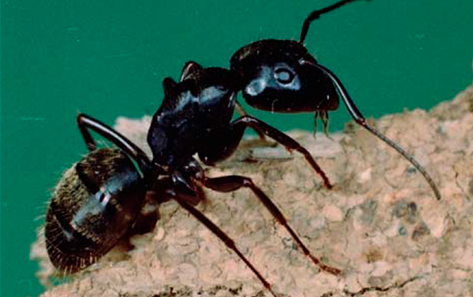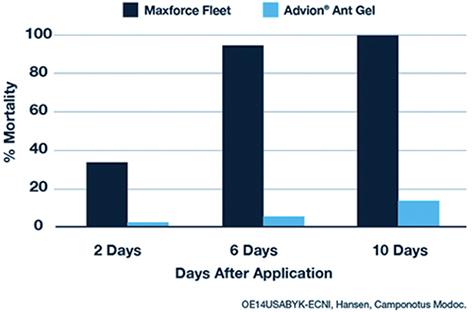Carpenter Ant Control with Maxforce<sup>®</sup> Fleet™
The term “Carpenter Ant” is used to describe 10-12 common species of the ant genus Camponotus. Four species of Camponotus are the most common structure-invading and damaging ants. Carpenter ants can be identified by these features: one-node on the pedicle; workers are polymorphic (size is variable within the colony); the profile of the thorax is evenly rounded with no spines; and in most forms the anus is surrounded by a small circle of hairs. Color is variable, but most common species are black or a combination of black and dark red.
Carpenter ant colonies are founded by mated single queens. The single-queen colonies range from a few hundred to 15,000 ants in the east, or over 100,000 ants in the west. A carpenter ant colony can survive for over 15 years.
Once well secured in a natural site, a carpenter ant colony will establish a series of satellite colonies as far as hundreds of feet from the parent colony. Almost all colonies that establish in and damage structures are satellite colonies. Parent colonies (containing the queen, eggs, young larvae, and nursery workers), are connected to satellite colonies (containing late instar larvae, pupae, swarmers and foraging workers) by well defined ‘trunk’ trails. These trails may be clearly observed by PMPs as narrow paths devoid of vegetation or leaf litter.
In structures, carpenter ants will exploit areas where prolonged exposure to moisture has softened or weakened structural wood. Once established the satellite colony may expand into more sound wood and voids within the building.
Carpenter ants do not eat wood like termites. They chew wood to expand their colony site and dispose of the excavated wood as ‘frass’. PMPs will observe the discarded frass close to nest sites, usually underneath a nest opening or ‘window’. Left unchecked, carpenter ants will cause significant structural damage to homes. Carpenter ant elimination is best achieved by delivering an insecticide to the parent colony, killing the queen. Always read and follow label directions of insecticides.
An effective method to deliver active ingredients throughout the colony quickly is the use of baits. Like other ants, carpenter ants regularly share foods through cross-feeding, known as trophallaxis. Maxforce Fleet will eliminate foraging carpenter ants and kill the parent colony as well.
Maxforce Fleet is specifically formulated for Camponotus species. This high-moisture gel bait mimics natural honeydew, an important food source of ants. Maxforce Fleet also contains an ingredient that attracts carpenter ants. Apply gel along ant foraging trails, in cracks and crevices where ants occur, in cracks and voids where ants enter, or directly into nest sites. Apply Maxforce Fleet on the trunks of trees that contain parent and satellite nests. These trees can be identified by observing steady ant trailing up and down the trunk. Because carpenter ants forage primarily at night, apply the gel as late in the day as possible.
// (Clemson University – USDA Cooperative Extension Slide Series, www.ipmimages.org)
Maxforce Fleet is most effective in spring when carpenter ants are foraging for high-protein foods. Specially formulated with a balanced food matrix, this ready-to-use granular bait can be applied outdoors along ant trails, around the base of nest trees, as a perimeter treatment around buildings and as a broadcast treatment in yards. Indoors, Maxforce Fleet can be applied into cracks and crevices, into wall and cabinet voids and broadcast in attics and basements that are inaccessible to children and pets.
Maxforce Ant Bait Stations (containing either hydramethylnon or fipronil) can be used to control carpenter ants, especially when no colonies are located in the structure. These child-resistant stations can be used wherever ants are a problem. The balanced bait matrix can be inspected through the red-tinted, clear lid. An adhesive back allows for placement on vertical or under surfaces.
Advion is a registered trademark of Syngenta.
For more information, contact your local Envu Pest Management & Public Health Representative.


